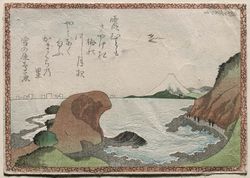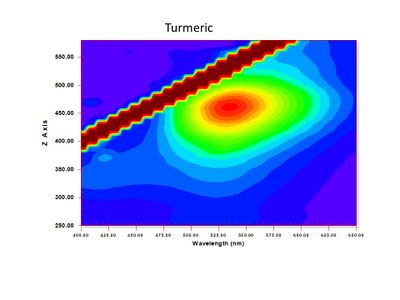Difference between revisions of "Category:Orpiment: Ukiyo-e colorant"
| Line 1: | Line 1: | ||
[[File:SC155045.jpg|right|250px|link=https://collections.mfa.org/objects/207552/kamakura-village-from-an-untitled-series-of-westernstyle-l?ctx=1be86594-d25a-458d-827f-8e5dc3048977&idx=0|Kamakura Village by Katsushika Hokusai]] | [[File:SC155045.jpg|right|250px|link=https://collections.mfa.org/objects/207552/kamakura-village-from-an-untitled-series-of-westernstyle-l?ctx=1be86594-d25a-458d-827f-8e5dc3048977&idx=0|Kamakura Village by Katsushika Hokusai]] | ||
| − | <font size="3">'''[[Orpiment]]'''</font> | + | <font size="3">'''[[Orpiment]]'''</font> 石黄(''sekio''): A natural yellow or brown dye obtained from the root the ''Curcuma domestica'' (or ''C. longa'') plant native to India and southeast Asia. Turmeric was used in Polynesia as a textile and skin dye. It was known in Mesopotamia and used by the ancient Greeks and Romans. When it was imported to Europe is 1612, it became a popular yellow dye for [[silk]] scarves. The roots are dried then powdered for sale. The primary color component in turmeric is curcumin. It is a water-soluble dye that forms a bright yellow color on [[cotton]] without a [[mordant]]. Darker orange to brown shades are produced with [[alum]], [[ tin]], [[chromium|chrome]], and [[copper]] mordants. [[Iron]] mordants produce a dull green shade. The fugitive colorant was also used to make [[yellow pigments]] and to tint varnishes. Turmeric is currently used as a flavoring agent in curry powder and as a yellow colorant in mustard, cheese, [[paper]], [[wood]], and [[wax]]. |
'''For more information see:''' [[Orpiment]] | '''For more information see:''' [[Orpiment]] | ||
Revision as of 20:08, 13 May 2020
Orpiment 石黄(sekio): A natural yellow or brown dye obtained from the root the Curcuma domestica (or C. longa) plant native to India and southeast Asia. Turmeric was used in Polynesia as a textile and skin dye. It was known in Mesopotamia and used by the ancient Greeks and Romans. When it was imported to Europe is 1612, it became a popular yellow dye for Silk scarves. The roots are dried then powdered for sale. The primary color component in turmeric is curcumin. It is a water-soluble dye that forms a bright yellow color on Cotton without a Mordant. Darker orange to brown shades are produced with Alum, Tin, chrome, and Copper mordants. Iron mordants produce a dull green shade. The fugitive colorant was also used to make Yellow pigments and to tint varnishes. Turmeric is currently used as a flavoring agent in curry powder and as a yellow colorant in mustard, cheese, Paper, Wood, and Wax.
For more information see: Orpiment
Examples of Orpiment in Ukiyo-e Prints

|

|

|

|

|
Analysis
Fiber optic reflectance spectroscopy (FORS) can easily identify the three blues: indigo, dayflower, and Prussian blue.
Other Images of Orpiment
List of Prints
List of prints where indigo was detected
Pages in category "Orpiment: Ukiyo-e colorant"
The following 54 pages are in this category, out of 54 total.
B
E
- Eisen, Fujieda: Kichô of the Owariya, from the series A Tôkaidô Board Game of Courtesans: Fifty-three Pairings in the Yoshiwara, 11.17946
- Eisen, Kawasaki, No. 3 from an untitled series of the Fifty-three Stations of the Tôkaidô Road, 11.25617
- Eisen, Minazuru-hime as Ono no Komachi and Benkei as Kisen Hôshi, from the series Characters from the Life of Ushiwaka as the Six Poetic Immortals, 11.25669
- Eisen, Seijûrô and Onatsu; Banners of Bishamonten; from the series Amusements on the Festival Day, 11.17904
- Eisen, The Song Evening Mist at Asama Peak, on Scrap-paper Fabric with an Itchû-bushi Libretto, from the series A Modern Pine Needle Collection, 11.17878
- Eishi, Shizuka of the Shizutamaya, from the series Beauties of the Yoshiwara as Six Floral Immortals, 21.4917
- Eishi, Shizuka of the Shizutamaya, from the series Beauties of the Yoshiwara as Six Floral Immortals, 53.21
- Eishi, Utamaki of the Takeya, kamuro Futaba and Midori, from the series New Year Fashions as Fresh as Young Leaves, 34.336
H
- Harunobu, Beautiful Women of the Yoshiwara, Combing hair (2006.1537.1)
- Harunobu, Courtesan Watching Two Kamuro Make a Snow Dog, 21.4463
- Harunobu, Nishikigi of the Kanaya Lighting Incense beside a Mosquito Net, 11.16479
- Harunobu, Osen of the Kagiya and a Young Man with a Cat, 11.19496
- Harunobu, Parody of Saigyô Hôshi: Courtesan Looking at a Screen Painting of Mount Fuji, 11.19431
- Harunobu, Young Woman Tuning a Shamisen, 06.479
- Hiroshige I, Naitô Shinjuku, Yotsuya, from the series One Hundred Famous Views of Edo, 11.35823
- Hiroshige I, Pine of Success and Oumayagashi, Asakusa River, from the series One Hundred Famous Views of Edo, 11.17029
- Hiroshige I/Hiroshige II, Ueno Yamashita, from the series One Hundred Famous Views of Edo, 11.35842
- Hokkei, Goat Standing by a Plum Tree, 21.9277
- Hokkei, Ômori, from the series Souvenirs of Enoshima, a Set of Sixteen, 11.19845
K
- Kiyomitsu I, Actor Segawa Kikunojô II as Seryômura Okiku, 11.18992
- Kiyonaga, A Matchmaking Meeting at a Teahouse by a Shrine, 21.5574
- Kiyonaga, Actors Matsumoto Kôshirô IV as Ukita Sakingo and Sawamura Sôjûrô III as the Ghost of Takao, with chanters Tomimoto Itsukidayû and Tomimoto Awatayû, and accompanist Sasaki Ichishirô, 11.13921
- Kiyonaga, Actors Matsumoto Kôshirô IV as Ukita Sakingo and Sawamura Sôjûrô III as the Ghost of Takao, with chanters Tomimoto Itsukidayû and Tomimoto Awatayû, and accompanist Sasaki Ichishirô, 21.5476
- Kiyonaga, The Brine Maidens, from the series Current Manners in Eastern Brocade, 11.13880
- Kiyonaga, The Brine Maidens, from the series Current Manners in Eastern Brocade, 21.5610
- Kiyonaga, Women Visiting Enoshima, 11.21277
- Kokan, Couple Cooling Off on a Garden Bench, 11.19524
- Kunisada, Actor Sawamura Tanosuke II, from the series Actor Rebuses, 11.42324
- Kunisada, Poem by Ariwara no Narihira Ason: (Actor Ichikawa Danjûrô VIII as) Seigen, from the series Comparisons for Thirty-six Selected Poems, 11.42663
- Kunisada, Young Woman Pointing and Giggling, from the series Types of the Floating World Seen through a Physiognomist's Glass, 34.471
- Kuniyoshi, Actor Ichikawa Kodanji IV as the Ghost of Asakura Tôgo, 11.30460
- Kuniyoshi, Hosokute: Horikoshi Dairyô, from the series Sixty-nine Stations of the Kisokaidô Road, 11.28766
- Kuniyoshi, Takeout Sushi Suggesting Ataka, from the series Women in Benkei-checked Fabrics, 11.36360
- Kuniyoshi, Tsumagome: Abe no Yasuna and the Fox Kuzunoha, from the series Sixty-nine Stations of the Kisokaidô Road, 11.41803
S
- Sharaku, Actor Osagawa Tsuneyo II as Ippei's Older Sister Osan, 11.14673
- Sharaku, Actor Osagawa Tsuneyo II as Ippei's Older Sister Osan, 11.14674
- Sharaku, Actor Osagawa Tsuneyo II as Ippei's Older Sister Osan, 21.7244
- Shigemasa, Perspective Picture of the Sleeping Dragon Plum in the Plum Garden at Kameido, 11.14977
- Shinsai, Chapters 22–24, from the series The Tale of Genji, 11.20034
- Shinsai, Chapters 25–27, from the series The Tale of Genji, 21.9264
- Shunkō, Actors Ichikawa Danjûrô V as Fukurokuju, Iwai Hanshirô IV as Ryûyô Dôji, and Sawamura Sôjûrô III as Shin'yô Dôji, 11.14971
- Shunkō, Actors Nakamura Nakazô I and Ôtani Hiroji III, 11.2014
- Shunshō, Actor Segawa Kikunojô III as Shirokiya Okoma, from the series Fans of the East, 11.14871
- Shunshō, No. 6, Cui Zongzhi (Saisôshi), from the series Eight Immortals of The Wine Cup, 11.14847
T
- Taito II, Court Lady and Pine Shoots, 21.9244
- TEST-Utamaro I, Women Overnight Guests, a Triptych, 21.6328-30
- TEST-Utamaro I, Women Overnight Guests, left panel of triptych, 21.6328
- Toyoharu, A Fashionable Picture of Wada's Banquet, from the series Scenes of Japan in Perspective Pictures, 54.1499
- Toyoharu, The Armor-pulling Scene at Wada's Banquet, 11.14704







